What Is Cachaça? Get to Know the Spirit Behind Rio's Caipirinhas

Getty Images
A trip to Brazil's Copacabana Beach may not be in the cards, but you might hear Samba music playing when you sip a cocktail made with cachaça, the South American country's national spirit. Not familiar with the sugarcane-based liquor? Most frequently mixed in a Caipirinha cocktail muddled with lime, cachaça (pronounced 'kah-SHA-sah') is showing up in more bars and mixed drinks all the time.
By law, cachaça must be produced in Brazil and contain alcohol of 38 to 48 percent by volume. Made from fresh sugarcane juice which is fermented and distilled, cachaça may be stored in stainless steel containers or wood barrels. White (branca) cachaça is the product of stainless steel or woods that do not impart any color. A variety of Brazilian woods can be used for storing cachaça, leading to yellow (amarela) cachaça, enhanced aromas, and softer flavors. For example, amburana reduces acidity and imparts suggestions of cinnamon and vanilla. The spirit may also be aged for at least one year (premium) or at least three years (extra premium).

iStockphoto/Getty Images
Chef Ed Verner of Boxer, Auckland's drinks-focused experiential bar, told Travel + Leisure, "As someone who uses a lot of indigenous plants in my cocktails to show off the flavors of New Zealand and its terroir, I really appreciate that cachaça is one of the rare spirits in the world that gets to change and mature in wood from its own country."
Now back to cocktails… the Caipirinha ('kai-peer-EEN-yah') is made with lime, sugar or simple syrup, ice, and two ounces of cachaça in an old-fashioned glass. With some variations, the basic process is to muddle a sliced or quartered lime with sugar, add ice cubes, add the cachaça, stir, and garnish with lime. A Batida (meaning shaken) Rosa includes soda, pineapple juice, lemon juice, and grenadine, according to Difford's Guide for Discerning Drinkers, just one of 20 cachaça-based cocktails they suggest. Chef Verner uses cachaça in a spritz-type cocktail with chardonnay, club soda, tartaric acid, and optional eucalyptus smoke.
Cachaça has been described as spicy, sweet, fruity, vegetal, and even funky. In IWSC (International Wine and Spirits Competition) tastings, the highly rated 2019 Cachaça Alambique Brasil Ouro Amburana was described as follows: "The nose offers all manner of green, grassy, and floral notes. The palate is all Christmas cake and pumpkin spice which carries through to the finish." The 2019 Cachaça Tellura Prata received a score of 93 for its "light vegetal grassy and floral notes on the nose. All sugarcane aromas that continue on the palate."
Cachaça dates back to the 1500s, at least 100 years before rum arrived on the scene. Cachaça is often confused with rum, and it was even referred to as "Brazilian rum" until a formal agreement between the U.S. and Brazilian governments established that it must be called "cachaça." The main difference between the two spirits is that rum is traditionally made from molasses, while cachaça is made from fresh-pressed sugarcane juice.
Mark your calendars for September 13, Dia Nacional da Cachaça (National Cachaca Day) celebrated in Brazil to commemorate a successful revolt against a Prohibition of sorts that forced the King of Portugal to legalize cachaça in 1661. This gives you some time to buy your own bottle and mix a cocktail or two before the big day. Here's one version of the "Perfect Caipirinha," but you'll discover your own favorite after a few tries.

